hidden in plain view
kate warren: gertrude street projection festival 2011
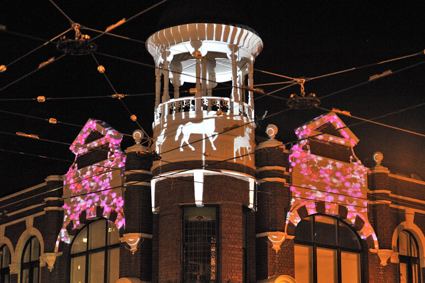
Projection Playground, Olaf Meyer, Gertrude Street Projection Festival 2011
photo Bernie Phelan
Projection Playground, Olaf Meyer, Gertrude Street Projection Festival 2011
THE RECENT ANNOUNCEMENT THAT RENOWNED FITZROY VISUAL ARTS INSTITUTION GERTRUDE CONTEMPORARY MAY FACE AN UNCERTAIN FUTURE WITH ITS BUILDING BEING PLACED ON THE MARKET HAS RENEWED DISCUSSIONS ABOUT THE INCREASING GENTRIFICATION OF THE INNER SUBURBS OF MELBOURNE. GERTRUDE STREET IN FITZROY HAS FORMED A LOCUS OF SUCH DEBATES, HAVING WITHIN A GENERATION TRANSFORMED FROM A GRUNGY, NEGLECTED STRIP INTO A SOUGHT-AFTER PRECINCT OF GALLERIES (COMMERCIAL AND NOT-FOR-PROFIT), DESIGNER BOUTIQUES, QUEUE-INDUCING BARS AND HIGH-END RESTAURANTS.
Gertrude Street epitomises the eternal progression as well as the contradictions of gentrification, linked strongly to Melbourne’s persistent, prolonged and generally successful attempts to increase its tourist appeal. Gertrude Street nowadays is a must-see local spot for visitors, yet amongst the high-end stores and eateries, the central and most recognisable buildings of Gertrude Street remain the Atherton Gardens housing commission flats while the locally infamous 86 tram—immortalised by the Bedroom Philosopher—tracks down the street on its way to and from Bundoora.
The Gertrude Street Projection Festival began in 2008 as the initiative of the Gertrude Association, an organisation established by local residents and business owners Kym Ortenburg and Monique McNamara, as a response to changes in the demographic of the street and the local area. For just over a week in late July, Gertrude Street transformed into a long, outdoor gallery of light and projection-based artworks, displayed on and at times integrated within the street’s architecture and commercial spaces. Involving 29 sites and over 50 artists the theme of this year’s festival was Hidden: Places & Spaces, with a particular emphasis on projects that engaged diverse local communities as participants and makers.
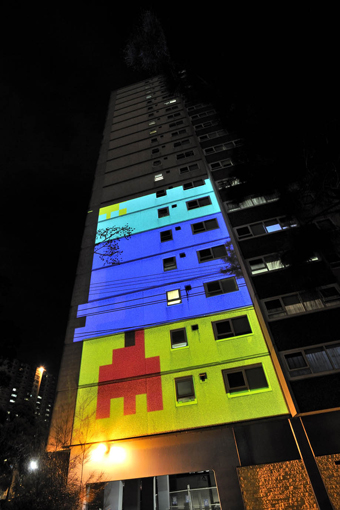
Façade, Greg Giannis, Gertrude Street Projection Festival 2011
photo Bernie Phelan
Façade, Greg Giannis, Gertrude Street Projection Festival 2011
Many such pieces could be seen to respond to an idiom of being ‘hidden in plain view.’ Greg Giannis’ Façade engaged with the architecture and residents of the housing commission flats, imposing structures in themselves yet all too easily disregarded (consciously or unconsciously) by passersby. Giannis’ work re-inscribed them into the Gertrude Street landscape by presenting an interactive, community-based piece. Through the artist’s website people could create their own images and designs to be projected throughout the festival on the south-facing façade through a colourful tetris-like grid. Fittingly, the blockish nature of the projected images also hinted at the standardised and homogenous nature of public housing architecture.
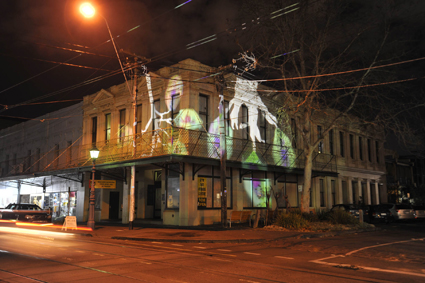
Stars & More, Arika Waulum, Yandell Walton, Gertrude Street Projection Festival 2011
photo Bernie Phelan
Stars & More, Arika Waulum, Yandell Walton, Gertrude Street Projection Festival 2011
Particular emphasis was placed on the Indigenous history of the local area, connecting the festival’s theme to a sense of forgotten histories and rarely told stories. In addition to a camp-fire storytelling night at the Atherton Gardens involving elders and members of the local Indigenous community, vital places of Indigenous culture and history were highlighted through the 10-night projection series, in particular an imposing but relatively overlooked building on the corner of George Street, The Melbourne Aboriginal Youth, Sport and Recreation Centre (MAYSAR). This was the site of one of the festival’s most visible projects, with Indigenous artist Arika Waulu working with Yandell Walton to create a large-scale projection, Stars & More, on the building’s exterior. Combing archival images and photos of current MAYSAR participants with imagery of native Australian flora and Indigenous dancers, the piece presented a powerful image of ongoing and regenerative cultural practice. Waulu and Walton’s project re-animated a place of importance and ongoing involvement for Fitzroy’s Indigenous community, which remains perhaps little-known to many residents as well as passersby.
A number of the pieces were equally prominent—anything but hidden—projected large-scale onto recognisable buildings such as the Gertrude and Builders Arms Hotels. Olaf Meyer’s Projection Playground re-envisioned the Post Office rotunda as a spinning merry-go-round, offering a playful and compelling beacon and invitation to explore the outdoor gallery.
The festival largely reinforced a conceptualisation of time-based practice within public art, but moved it away from screen-based presentations. In contrast to pieces that enveloped the architecture of entire buildings, a number of artworks integrated themselves obliquely and unassumingly into the environment. In a sense, many reclaimed the spaces of commercialised interests in Gertrude Street for artistic expression and collaboration. Salote Tawale’s In the Bag elicited surprised responses from viewers as they searched for and eventually found the discreet installation in the window of a Crumpler store, with the video being precisely projected within one of the label’s distinctive bags. The piece illustrated the constraints to creativity by incorporating the image of the artist writing, sleeping and inhabiting a confined environment.
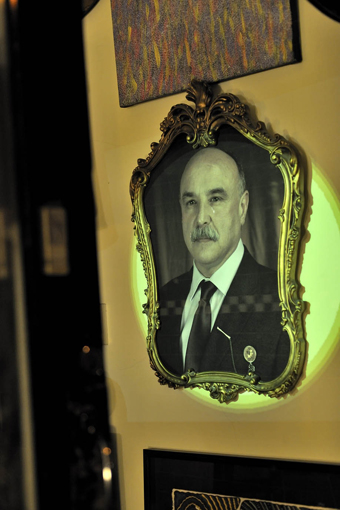
Portrait of a Man 1, Yandell Walton, Clare Hassett, Gertrude Street Projection Festival 2011
photo Bernie Phelan
Portrait of a Man 1, Yandell Walton, Clare Hassett, Gertrude Street Projection Festival 2011
Yandell Walton and Clare Hassett’s intervention into Francis Antiques, Portrait of a Man 1, reconceived a symbol of decorative and homely adornment into an image of reserved melancholia. Taking a rather unremarkable portrait of a male figure on display in the store, the artists subtly projected a fine track of tears down the figure’s cheek, hinting at some unknowable story or secret. It was a poetic reminder of the memories and narratives attached to and embodied within objects, so easily lost and forgotten once personal ephemera become ‘second-hand’ objects of trade.
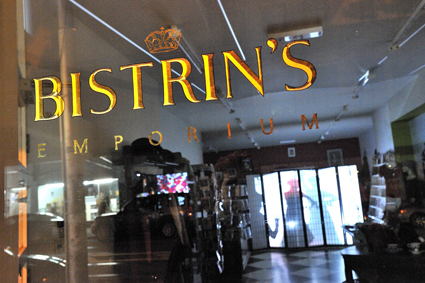
The Encounter with the Shadow, Sabina Maselli, Gertrude Street Projection Festival 2011
photo Bernie Phelan
The Encounter with the Shadow, Sabina Maselli, Gertrude Street Projection Festival 2011
Other artworks offered fantastical and imaginative musings on the ‘inner lives’ of their inhabited spaces. Sabina Maselli’s elegant The Encounter with the Shadow revealed the ‘second life’ of the Gertrude Street store Bistrins Emporium—which doubles as a venue for evening dance classes. By incorporating an animated and silhouetted flamenco dancer against a folding screen in the shop’s rear, the piece evocatively re-activated the this space.
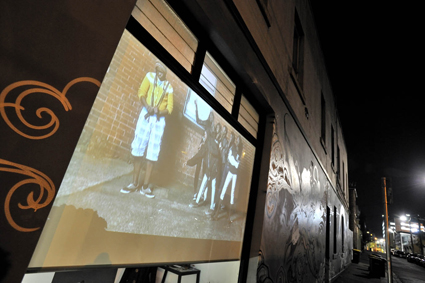
Fitzroy Learning Network, Gertrude Street Projection Festival 2011
photo Bernie Phelan
Fitzroy Learning Network, Gertrude Street Projection Festival 2011
Ultimately, some of the most moving pieces in the festival were the most modest in nature, made by and reflecting a diversity of local community groups. Located off Young Street and rather easy to miss was a simple photo montage—barely a few frames—offering a poignant image. Created by students at the Fitzroy Learning Network, the piece illustrated a group of young people shunning and physically excluding one of their peers from their friendship group. The piece resonated within the cold and dark streets, simply conveying the vital importance of individual and community bonds. Amongst the visually spectacular and crowd-pleasing installations of the festival, it was pleasing to discover that some of the most memorable artworks really were hidden, or at least requiring some patience and searching from the viewer, even on a chilly Melbourne winter’s evening.
Gertrude Association, The Gertrude Street 2011 Projection Festival , founding concept Monique McNamara, creative producer, director Kym Ortenburg; various sites, Gertrude Street, Fitzroy, July 22-31; www.thegertrudeassociation.com
RealTime issue #104 Aug-Sept 2011 pg. web






